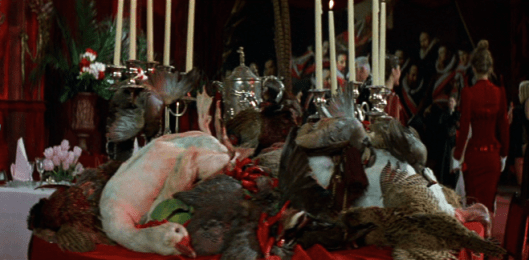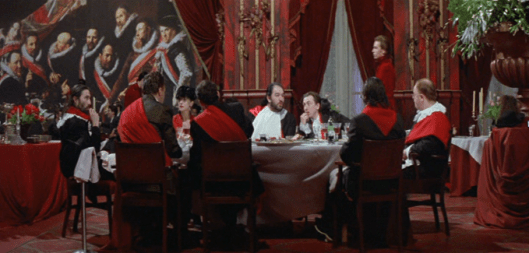Tags
Ciarán Hinds, Donald Trump, Michael Gambon, Peter Greenaway, The Cook, The Thief His Wife and Her Lover
When Peter Greenaway’s The Cook, The Thief, His Wife & Her Lover was released twenty-eight years ago, it went unrated in the US because the only other choice was “X,” the same rating given to hard-core pornography. I remember reading at the time that it was a grotesque, overheated tale of cannibalism. I had no desire to see it.

“I’ll kill him, and I’ll eat him!!”
Two circumstances changed that. First, Michael Gambon (yes, Dumbledore) is being honored with an IFTA Lifetime Achievement Award for his six-decade career as a stage and screen actor. Second, for five years I have nursed a mad ambition to see every film and TV show in which Ciarán Hinds appears, and this was one of the last items on the list.

One of Spica’s henchmen, Corey Peterson (Ciarán Hinds), cozies up to a hostess (Alex Kingston) in the restaurant.
Most of the first hour is spent making viewers queasy by juxtaposing bodily functions which we normally keep separate. In the first scene, Albert Spica, the thuggish new owner of a lavish restaurant, is shown forcing dog feces into the mouth of a hapless man who owes him money. Over dinner, he discourses on human milk as a delicacy for adults, and the drinking of urine by ascetics in India, while harshly critiquing the table manners and personal grooming of his lackeys. (Inevitably I thought: this is not my cup of wee.)

Greenaway’s compositions are always painterly: Spica’s naked victim is at center; the two vans hold seafood (left) and meat (right) intended for the kitchen, but which are rejected by the Cook.
Then Spica’s elegant but much-abused wife, Georgina, exchanges glances with a man at another table, who has brought only a book for company. Soon, she meets him in the ladies’ room for a passionate tryst. Every night thereafter, Georgina and Michael find a hidden corner of the restaurant in which to make love under the very nose of the vicious Spica. When he learns the truth, he tortures Michael to death, stuffing the pages of his own books down his throat (this is the only part I could not bring myself to watch). But Georgina plans a most fitting revenge…

Helen Mirren gets to wear some stunning lingerie in this film (all the costumes, by Jean-Paul Gaultier, are riveting). There is plenty of nudity and sex too, but it seems wholesome next to the grotesquerie and brutality of the other images.
Several reviewers have described the film as a political allegory of the arrogance, crassness, and callousness of Thatcherism. Ergo, the Cook is the well-meaning citizen who nevertheless collaborates with bullies and thugs; the Thief is consumerist culture led by the rapacious power class; the Wife is helpless Britannia, imprisoned in a sterile union, and the Lover is the intellectual Left, full of desire but too weak to rescue his beloved.
A good allegory transcends the specific situation for which it was written. And so it is with Cook, Thief, which contains some uncanny parallels to Trump and his nauseating court. Indeed, it was the Long Suffering Husband who first made the connection, pointing to Spica’s absurd neckwear.

Both Spica and Trump wear their neckties about four inches too long, extending well below the belt.

Spica has an obsessive need to affix his name in large letters on the restaurant he owns. Greenaway makes a visual joke by first having the letters spell “ASPIC,” a kind of meat jelly.

Thuggish Spica demonstrates his contempt for education and the intellect by twice grabbing books from Michael’s table and dashing them to the floor.
Spica becomes more and more violent, harassing the other diners and eventually driving them from the restaurant. The only man to challenge him openly is Corey, after Spica hassles his girlfriend.

Corey: “Don’t treat a woman like that!” Spica: “I’ll do what I like.”
After ramming a fork into the girlfriend’s face, Spica goes on to remark that he could stand in the middle of Fifth Avenue and shoot someone if he liked, and not lose voters… oops, different bully.
He judges women on sexual attractiveness and feels free to belittle and grope them…

“A cow’s got great big tits, just like you, eh, Georgy?”
Spica measures men by how they look, too. He finds his henchman’s jacket ill-fitting and his fingernails a disgrace:

“Why can’t I have some bloody quality in my associates?” Yes, that’s a young Tim Roth next to Spica.
He surrounds himself with opulence and plenty, but doesn’t have much compassion for the poor, especially if they are foreigners:

Spica: “I think these Ethiopians like starving… yah, it keeps them slim and graceful.”
Not satisfied with the over-the-top decor of Le Hollandais (complete with 17th-century Dutch-style arrangements of food and a Frans Hals mural), he decides that something is missing:

“This place is too dark… Gold! It needs more gold!”

Because you can never have enough gold.

I’m fully gob smacked. Holy crap. Wow. The comparisons are stark and dead on, and timely. If you’d seen this even a year ago, think of how much you would have missed.
That’s true, Ellen! I’m glad I waited all this time. It’s quite a performance by Michael Gambon, I must say. He is absolutely and relentlessly horrid. And when he loses his temper, it’s scary.
So you decided to watch it! Love the Trump analogy, great observation LM and the long tie is hilariously awful. I watched this movie years ago through splayed hands and had to close my eyes often. I could never, ever watch it again although I appreciate the film making.
Indeed it is hard to watch, but I think that the violence of cable television has caught up with it. It was worth it for the luscious images of a long-haired, bearded Mr. H., looking simultaneously feral and elegant.
Wonderful analysis and frightening analogies! Kudos to the LSH for spotting that tie-in (sorry) to the bigger picture of what the film represents. Though I suspect it’s true that its sly commentary was aimed at the Thatcher government, its parallels seem even more aligned to the over-the-top and excessive Trump regime. The gorgeous wastefulness of the piles of rotting foods also represents the disrespect of the bounties of nature (and, as such, disregard of the envirnonment). I found the film stunning in both its beauty and its filth. A true momento mori, as captured in those Dutch Master’s still lifes of lush fruits and flowers beginning to wilt and fade. I wonder if the analogy will continue to hold with the wife’s revenge.
“Tie-in” LOL! I think you’re right about the memento mori and the message about mindless wastefulness. Today, it rings true to the devastation of the environment and the emphasis on short-term profit at the expense of future generations. Also, for me, the rotting food represents ethical corruption and a retreat from Enlightenment values and human rights. As for Georgina’s revenge, Greenaway took it from Jacobean revenge tragedies, which sometimes featured cannibalism, drawing on Greek sources like the myth of Thyestes and Atreus. So far, it feels like the country is being forced to “swallow” Trump and not the other way around, but we’ll see.
Sorry for all the typos in my post! How embarrassing. Autocorrect has become my sworn mortal enemy.
Oh, I know. I have the same problem, especially on my phone, since I haven’t figured out how to turn it off.
I haven’t figured out how to simply “like” a comment but did enjoy your “tie in” to the article, Karen. 🙂
Thanks. Ellen! I was leery about seeing the film but found I really liked it for all of its subtle commentary, stunning visuals (including Mr. H.), and humor (shows what a sick puppy I am). I think you have to go into the post directly through WordPress to “like” a comment.
Yes, Mr. H. is in a lot of scenes where he’s in the frame, but not the focus of the action. It’s fun to watch what he’s doing and how he reacts to things. Plus–he looks amazing. I love the confrontation scene with Spica, where he has this gorgeous, loose shoulder-length hair. Another time, he wears a wide-brimmed hat with one side pinned up. He looks like a decadent pirate, LOL!
Brilliant! I shudder to think how real life will play out, but what a lovely bit of writing and astute analysis.
Many thanks, Happy Gourmand! I feel reconciled to this film now, which I was afraid to watch for five years.
Fascinating review-I have previously avoided this for precisely the reasons you mention…but now, one to watch. Thank you
I found the first hour rough going, because it is a bit repetitive, with all of Spica’s terrible monologues. But then in the second half, the story really gets moving.
Wow! I have not seen this movie but wow on the analogies! Eerie… Great post, Linnet!
Thanks, Esther. I didn’t know what to expect, but it wasn’t this!
Wow… glad you managed to see it in the end, very metaphorical it seems and interesting for it as long as one can stomach the visuals of the metaphors 😉 Good to challenge oneself from time to time 🙂
It was indeed challenging. The first viewing was difficult, but then when I went back to make the screencaps, I really enjoyed it. I think that’s probably typical of Greenaway films, that the greatest pleasure is in the images and the composition of the shots, as well as the details in the background, which you miss when trying to follow the story. On the other hand, I don’t recall that “Prospero’s Books” even HAD a story.
Your writing is so entertaining! Great photo comparison of the long ties.
Sounds like there were a lot of moments I’d have to look away from in this film (I hate torture scenes) but the ‘aspic’ detail is too funny. A meat jelly! What a terrible idea. I think that describes Trump perfectly—meaty and gelatinous. I can’t think of a way to tie that into Trump’s name, but wouldn’t it be “really great” if we could?
I’ve always wondered what would happen if I decided to present an aspic at a dinner party. The closest I’ve ever come to seeing one was when I tried to make cassoulet (a major failure). I took a photo of the jelly that surfaced during some stage of the three-day-long process and sent it to a friend with a question, “Should I just give up? This goo looks disgusting.” She wrote back, “Trust the goo.”
Well, no. Do not trust the goo. At least not that much goo. And don’t trust the Silver Palate cookbook on that recipe.
LOL! I thought the same, that “meat jelly” is a good analogy for Trump. He is not substantive but squishy. Ugh. I believe that aspic is a classic of French cooking, and those jello rings with little bits of fruit or veg inside are direct descendants!
After watching CTWL, I am almost inspired to tackle “Prospero’s Books,” though when we saw it in a cinema, I was unable to sift any story from it. Apparently Greenaway thinks that visual storytelling is obsolete.